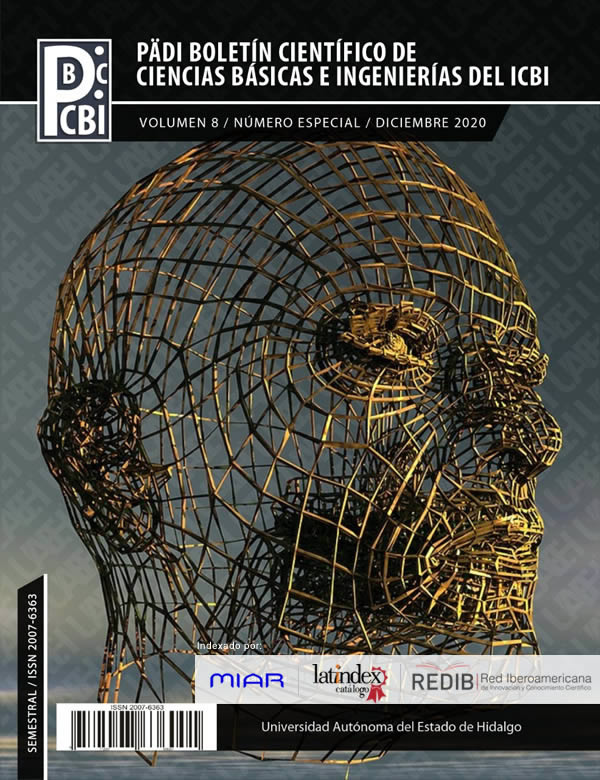Simulation of the extraction time as a function of the process temperature and the microstructure of the plant material
Abstract
Solid-liquid extraction from plant sources is a widely used bioseparation for obtaining organic substances of interest in the food, pharmaceutical, and cosmetic industries. In the present work, the extraction operation with the solved Simpson model was studied by fractional calculation of the anomalous diffusion expression of Fick's second law to study the effect of microstructure and temperature on extraction behavior and time of extraction. The determination of this time is of great importance for the process since if it’s not reached, the yield obtained from the vegetable source decreases and if it’s higher, it reduces its profitability, for this a novel numerical method was proposed that defines the extraction time one in which there is a marked change in the extraction speed. The simulation was carried out with Matlab and the parameters of the model that represent the effect of the microstructure (n) and the effect of temperature (k) were individually and combined in a range of 80% to 120% of their initial value. The adjustment of the experimental data to the Simpson model presented an R2 of 0.998, while the evaluation of the parameter k (temperature) showed to have less consequence in the behavior and extraction time than the parameter n (microstructure) which presented extraction times of 507.8 to 14.5 min. and from 79.3 to 46.6 min. for n and k respectively. The results of the simulation were consistent with those observed in biomaterials with clearly different structures such as those of seeds and fruits processed at different temperatures, so the proposed numerical methods can be a useful tool in this bioseparation.
Downloads
References
Aguilera, J. M. (2005). Why food microstructure? Journal of Food Engineering, 67(ISSN 0260-8774), 3-11.
DOI:10.1016/j.jfoodeng.2004.05.050
Cerón-Montes, G. S.-M.-F.-C.-M. (2015). Preliminary purification of anthocyanins from blue corn by adsorption and electrophoresis. . Revista mexicana de ingeniería química, 14(1), 99-108. http://www.scielo.org.mx/scielo.php?script=sci_arttext&pid=S1665-27382015000100009&lng=es&tlng=en.
E. Vittadini, Y. V. (2007). Effects of water distribution and transport on food microstructure. In Woodhead Publishing Series in Food Science, Technology and Nutrition, Understanding and Controlling the Microstructure of Complex Foods, Woodhead Publishing(ISBN 9781845691516), 89-112.
DOI:10.1533/9781845693671.1.89.
Hip Seng Yim, F. Y. (2012). Optimization of extraction time and temperature for antioxidant activity of edible wild mushroom, Pleurotus porrigens, Food and Bioproducts Processing. 90(ISSN 0960-3085), 235-242.
DOI:10.1016/j.fbp.2011.04.001.
Hu, Q. P. ((2007) ). Effects of supercritical carbon dioxide extraction conditions on yields and antioxidant activity of Chlorella pyrenoidosa extracts. (J. o. Engineering, Ed.)
DOI: 10.1016/j.jfoodeng.2006.06.026
Inoue, T. T. (2010). Isolation of hesperidin from peels of thinned Citrus unshiu fruits by microwave-assisted extraction. Food Chem., 123 (2), 542–547. DOI: 10.1016/j.foodchem.2010.04.051
Jurinjak A., B. M. (2016). Kinetics and thermodynamics of the solid-liquid extraction process of total polyphenols, antioxidants and extraction yield from Asteraceae plants. Journal Industrial Crops and Products, 91, 205–214. DOI: 10.1016/j.indcrop.2016.07.015
Kannan Mohan, T. M. (2020). Trends in the extraction, purification, characterisation and biological activities of polysaccharides from tropical and sub-tropical fruits – A comprehensive review. Carbohydrate Polymers, 238 (ISSN 0144-8617), 116-185.
DOI:10.1016/j.carbpol.2020.116185.
Kehinde Peter Alabi, Z. Z.-W. (2020). Transport phenomena and their effect on microstructure of frozen fruits and vegetables. Trends in Food Science & Technology, 101(ISSN 0924-2244), 63-72.
DOI:10.1016/j.tifs.2020.04.016.
Lapornik, B. P. (2005). Comparison of extracts prepared from plant by-products using different solvents and extraction time. Journal of Food Engineering, 71, 214–222.
DOI: 10.1016/j.jfoodeng.2004.10.036
Mohammad Kazem Rofouei, S. M.-P. (2021). Optimization of chlorogenic acid extraction from Elm tree, Ulmus minor Mill., fruits, using
response surface methodology. Separation and Purification Technology, 256(117773), ISSN 1383-5866.
DO:10.1016/j.seppur.2020.117773.
Nancy Cordoba, M. F.-A. (2020). Coffee extraction: A review of parameters and their influence on the physicochemical characteristics and
flavour of coffee brews. Trends in Food Science & Technology, 96(ISSN 0924-2244), Pages 45-60.
DOI:10.1016/j.tifs.2019.12.004.
Valencia Arredondo J. A., H.-B. G.-M.-M. (2020). Enhanced process integration for the extraction, concentration and purification of di-acylated cyanidin from red cabbage. Separation and Purification Technology, Volume 238(ISSN 1383-5866,).
DOI: 10.1016/j.seppur.2019.116492.
Valencia Pérez, N. S. (2017). Extracción de componentes bioactivos de residuos de alcachofa. Tesis, Unidad Profesional Interdisciplinaria de Biotecnología, Laboratorio de alimentos, CDMX. https://tesis.ipn.mx/bitstream/handle/123456789/27126/Valencia Pérez, Naella Sandivel.pdf?sequence=1&isAllowed=y
Pinelo M., S. J. (2006). Mass transfer during continuous solid–liquid extraction of antioxidants from grape by products. Journal Food Eng., 77, 57–63. DOI: 10.1016/j.jfoodeng.2005.06.021
Špela Stangler Herodež, M. H. (2003). Solvent extraction study of antioxidants from Balm (Melissa officinalis L.) leaves. Food Chemistry, 80(2), 275-282. DOI: 10.1016/S0308-8146(02)00382-5
Shasha Yu, Y. W. (2017). Structure, thermal stability, antioxidant activity and DFT studies of trisphenols and related phenols. Inorganica Chimica Acta, 468(ISSN 0020-1693), Pages 159-170,.
DOI:10.1016/j.ica.2017.07.022.
Simpson R., R. C. (2017). Trend in Food Science and Technology. Understanding the success of Page’s model and related empirical equations in fitting experimental data of diffusion phenomena in food matrices. DOI: 10.1016/j.tifs.2017.01.003
Simpson, R. J. (2013). Fractional calculus as a mathematical tool to improve the modeling of mass transfer phenomena in food processing. Food Engineering Reviews, 5, 45–55. DOI:10.1007/s12393-012-9059-7
Simpson, R. R. (2015). Diffusion mechanism during the osmotic dehydration of Granny Smith apples subjected to a moderate electric field. Journal of Food Engineering, 166, 204–211. DOI: 10.1016/j.jfoodeng.2015.05.027
Versteeg., N. S. (2011). Texture and Microstructure of Fruits and Vegetables. In Practical Food and Research, Chapter 4 (part I) , 6-20. ISBN: 978-1-61728-506-6.
Ziaedini A., J. A. (2010). Extraction of antioxidants and caffeine from green tea (Camelia sinensis) leaves: kinetics and modeling. Journal food science and technology international., 16(6), 0505-6. DOI: 10.1177/1082013210367567













